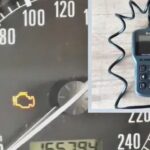It’s a common frustration: your new Bluetooth OBD2 adapter seems to pair perfectly with your phone or tablet, but when you open your favorite app like Torque, nothing happens. You’re left wondering why your devices won’t communicate and how to get your car diagnostics up and running. Let’s troubleshoot this issue and explore the reasons why your Bluetooth OBD2 adapter pairs but the Torque app refuses to connect and display your car’s data.
Understanding Bluetooth Pairing vs. App Connection
First, it’s important to distinguish between Bluetooth pairing and app connection. When you pair a Bluetooth device, you’re essentially establishing a basic wireless link between your phone/tablet and the adapter at the Bluetooth protocol level. This means your devices can “see” each other and exchange basic signals. However, pairing alone doesn’t guarantee that an application like Torque can successfully communicate with the OBD2 adapter and, more importantly, your car’s computer.
Alt: Bluetooth OBD2 adapter securely plugged into the OBD2 port beneath a car’s dashboard.
The Torque app, or any OBD2 application, needs to establish a further connection using specific communication protocols to retrieve diagnostic data from your vehicle. This is where things can go wrong even after successful Bluetooth pairing.
Common Reasons and Troubleshooting Steps
Several factors can cause your Bluetooth OBD2 adapter to pair but fail to work with the Torque app. Here’s a breakdown of common culprits and how to address them:
1. Incorrect App Protocol Settings
OBD2 adapters and apps communicate using various protocols (like ISO 9141-2, ISO 14230-4, ISO 15765-4 CAN, SAE J1850 PWM, SAE J1850 VPW). If the Torque app is configured to use the wrong protocol for your car, it won’t be able to establish a connection, even if the Bluetooth pairing is successful.
Solution:
- Check your car’s OBD2 protocol: You can usually find this information in your car’s manual or by searching online for your car’s make, model, and year along with “OBD2 protocol”.
- Configure Torque app protocol settings: In the Torque app settings, look for “OBD2 Adapter Settings” or “Connection Type”. Ensure the protocol is set to “Automatic” or manually select the protocol compatible with your car. Experiment with different protocols if unsure.
2. Adapter Type Mismatch in App Settings
Some OBD2 apps, including Torque, require you to specify the type of OBD2 adapter you are using (e.g., ELM327, STN1110). If you’ve selected the wrong adapter type in the app settings, it can lead to connection issues.
Solution:
- Verify adapter type: Identify the chipset of your Bluetooth OBD2 adapter. Many adapters use the ELM327 chip.
- Correct app adapter settings: In Torque’s settings, ensure the “Adapter Type” or similar setting is correctly configured to match your adapter (usually “ELM327”).
3. Bluetooth Connection Profile Issues
While less common with modern devices, sometimes the Bluetooth connection profile used for pairing might not be fully compatible with the data transfer needs of OBD2 communication.
Solution:
- Forget and Re-pair: In your phone’s Bluetooth settings, “forget” or “unpair” the OBD2 adapter. Then, re-initiate the pairing process. This can sometimes resolve profile mismatches.
- Restart Devices: Restart both your phone/tablet and your car (turn ignition off and on again) before re-attempting the connection. This can refresh Bluetooth connections and clear temporary glitches.
4. Faulty OBD2 Adapter or App Glitches
Although less frequent, the issue might stem from a defective OBD2 adapter or temporary bugs within the Torque app itself.
Solution:
- Test with another OBD2 app: Try using a different OBD2 app (like OBD Fusion, Car Scanner ELM OBD2) to see if it connects with your adapter. If another app works, the problem might be specific to Torque or its configuration.
- Test adapter on another vehicle (if possible): If you have access to another car, try using your OBD2 adapter and Torque app with that vehicle to rule out car-specific issues.
- Check for Torque app updates: Ensure you are using the latest version of the Torque app. App updates often include bug fixes and compatibility improvements.
- Contact Adapter Vendor/App Support: If all else fails, reach out to the vendor of your OBD2 adapter or the support team for the Torque app for further assistance.
Alt: Torque Pro app dashboard interface displaying real-time car diagnostic data on an Android smartphone.
Conclusion
When your Bluetooth OBD2 adapter pairs but the Torque app won’t work, don’t despair! By systematically checking your app settings, Bluetooth connection, and considering potential adapter or app issues, you can often pinpoint the cause and get your car diagnostics working smoothly. Remember to start with the simplest solutions like verifying protocol and adapter settings within the Torque app. With a bit of troubleshooting, you’ll likely be able to unlock the diagnostic power of your OBD2 adapter and Torque app combination.
Further Resources:
